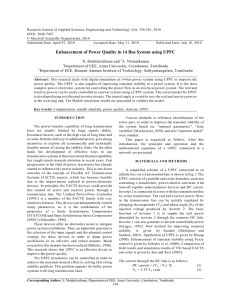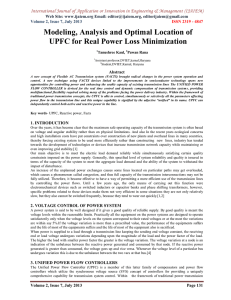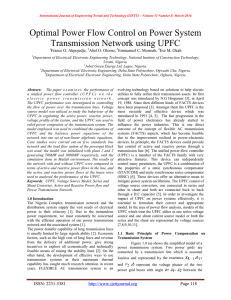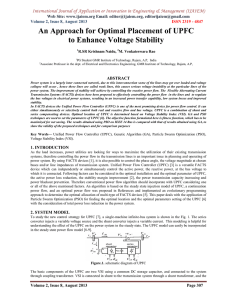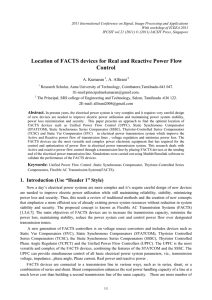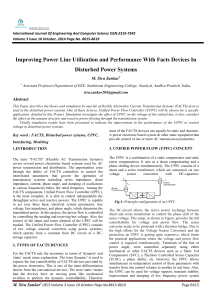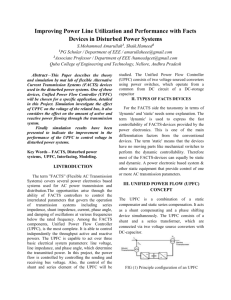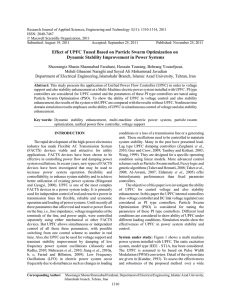Research Journal of Applied Sciences, Engineering and Technology 9(11): 1027-1033,... ISSN: 2040-7459; e-ISSN: 2040-7467
advertisement
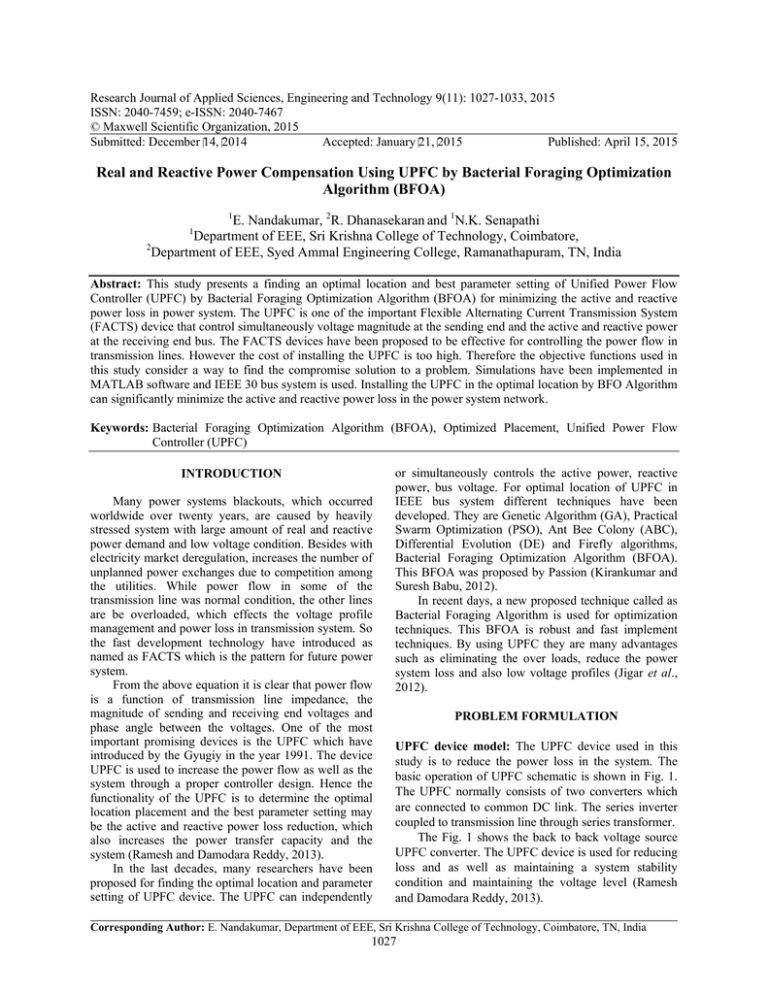
Research Journal of Applied Sciences, Engineering and Technology 9(11): 1027-1033, 2015 ISSN: 2040-7459; e-ISSN: 2040-7467 © Maxwell Scientific Organization, 2015 Submitted: December 14, 2014 Accepted: January 21, 2015 Published: April 15, 2015 Real and Reactive Power Compensation Using UPFC by Bacterial Foraging Optimization Algorithm (BFOA) 1 E. Nandakumar, 2R. Dhanasekaran and 1N.K. Senapathi Department of EEE, Sri Krishna College of Technology, Coimbatore, 2 Department of EEE, Syed Ammal Engineering College, Ramanathapuram, TN, India 1 Abstract: This study presents a finding an optimal location and best parameter setting of Unified Power Flow Controller (UPFC) by Bacterial Foraging Optimization Algorithm (BFOA) for minimizing the active and reactive power loss in power system. The UPFC is one of the important Flexible Alternating Current Transmission System (FACTS) device that control simultaneously voltage magnitude at the sending end and the active and reactive power at the receiving end bus. The FACTS devices have been proposed to be effective for controlling the power flow in transmission lines. However the cost of installing the UPFC is too high. Therefore the objective functions used in this study consider a way to find the compromise solution to a problem. Simulations have been implemented in MATLAB software and IEEE 30 bus system is used. Installing the UPFC in the optimal location by BFO Algorithm can significantly minimize the active and reactive power loss in the power system network. Keywords: Bacterial Foraging Optimization Algorithm (BFOA), Optimized Placement, Unified Power Flow Controller (UPFC) INTRODUCTION Many power systems blackouts, which occurred worldwide over twenty years, are caused by heavily stressed system with large amount of real and reactive power demand and low voltage condition. Besides with electricity market deregulation, increases the number of unplanned power exchanges due to competition among the utilities. While power flow in some of the transmission line was normal condition, the other lines are be overloaded, which effects the voltage profile management and power loss in transmission system. So the fast development technology have introduced as named as FACTS which is the pattern for future power system. From the above equation it is clear that power flow is a function of transmission line impedance, the magnitude of sending and receiving end voltages and phase angle between the voltages. One of the most important promising devices is the UPFC which have introduced by the Gyugiy in the year 1991. The device UPFC is used to increase the power flow as well as the system through a proper controller design. Hence the functionality of the UPFC is to determine the optimal location placement and the best parameter setting may be the active and reactive power loss reduction, which also increases the power transfer capacity and the system (Ramesh and Damodara Reddy, 2013). In the last decades, many researchers have been proposed for finding the optimal location and parameter setting of UPFC device. The UPFC can independently or simultaneously controls the active power, reactive power, bus voltage. For optimal location of UPFC in IEEE bus system different techniques have been developed. They are Genetic Algorithm (GA), Practical Swarm Optimization (PSO), Ant Bee Colony (ABC), Differential Evolution (DE) and Firefly algorithms, Bacterial Foraging Optimization Algorithm (BFOA). This BFOA was proposed by Passion (Kirankumar and Suresh Babu, 2012). In recent days, a new proposed technique called as Bacterial Foraging Algorithm is used for optimization techniques. This BFOA is robust and fast implement techniques. By using UPFC they are many advantages such as eliminating the over loads, reduce the power system loss and also low voltage profiles (Jigar et al., 2012). PROBLEM FORMULATION UPFC device model: The UPFC device used in this study is to reduce the power loss in the system. The basic operation of UPFC schematic is shown in Fig. 1. The UPFC normally consists of two converters which are connected to common DC link. The series inverter coupled to transmission line through series transformer. The Fig. 1 shows the back to back voltage source UPFC converter. The UPFC device is used for reducing loss and as well as maintaining a system stability condition and maintaining the voltage level (Ramesh and Damodara Reddy, 2013). Corresponding Author: E. Nandakumar, Department of EEE, Sri Krishna College of Technology, Coimbatore, TN, India 1027 Res. J. Appl. Sci. Eng. Technol., 9(11): 1027-1033, 2015 Fig. 1: Implementation of UPFC 𝑃𝑃𝑢𝑢1 + 𝑃𝑃𝑢𝑢2 = 0 Fig. 2: Decoupled method of UPFC (1) The range of shunt angle is 0 ≤ 𝜃𝜃𝑠𝑠ℎ ≤ 2𝜋𝜋, 𝑉𝑉𝑠𝑠ℎ and 𝜃𝜃𝑠𝑠ℎ are the magnitude and angle controllable for the shunt voltage converter the limit of the shunt converter is 𝑉𝑉𝑠𝑠ℎ 𝑚𝑚𝑚𝑚𝑚𝑚 ≤ 𝑉𝑉𝑠𝑠ℎ ≤ 𝑉𝑉𝑠𝑠ℎ 𝑚𝑚𝑚𝑚𝑚𝑚 . Likewise, the magnitude and angle controllable for the series voltage converter is in the range is 0 ≤ 𝜃𝜃𝑠𝑠𝑠𝑠 ≤ 2𝜋𝜋, the limit of series converter is 𝑉𝑉𝑠𝑠𝑠𝑠 𝑚𝑚𝑚𝑚𝑚𝑚 ≤ 𝑉𝑉𝑠𝑠𝑠𝑠 ≤ 𝑉𝑉𝑠𝑠𝑠𝑠 𝑚𝑚𝑚𝑚𝑚𝑚 Janathan and Palaniswami, (2012). As well as the shunt inverter is coupled to Objective function: The objective function of this transmission line through shunt transformer. The shunt study is to minimization of the real and reactive power inverter can generate or absorbs the reactive power and loss in transmission network which always consider an the series inverter satisfies the operating requirements. important issue in planning and operating terms in the The shunt converter is decomposed to two components power system. The UPFC device must be installed with (Syed and Mohammed, 2011). One component is in optimal location and parameter setting to minimizing phase and other component is quadrature with UPFC losses as much as possible Dong et al., (2007). By bus voltage. It can independently and very rapidly can installing the FACTS devices the cost plays an major control the both real and reactive power flows in a role and however in the general case the installation transmission line and its configuration is shown in Fig. cost of the UPFC is too high. So in this objective 1. The dc voltage for the both converter is provided by function is developed according to reduces the cost common capacitor bank which is shown in Fig. 1. function. The objective function in this study is The converter 1 is used mainly for supplying the summation of the two terms as shown (Ghamgeen real power demand of the converter 2; it drives from the et al., 2011b): transmission line. The net real power which is drawn from ac system is same or equal to the losses of the two min 𝐹𝐹 = ∑𝑛𝑛𝑛𝑛𝑛𝑛 𝑘𝑘=1 𝑃𝑃𝑃𝑃𝑘𝑘𝑘𝑘𝑘𝑘𝑘𝑘𝑘𝑘 + 𝛾𝛾 × 1000 × 𝐶𝐶𝑈𝑈𝑈𝑈𝑈𝑈𝑈𝑈 × 𝑆𝑆 (2) converters Basu (2008). The shunt converter which acts like an STATCOM and regulates the terminal voltage. The cost function of the UPFC is shown below: The UPFC has the capabilities of the voltage regulation, 2 series compensation and the phase shifting. The series − 0.2691𝑠𝑠𝐹𝐹𝐹𝐹𝐹𝐹𝐹𝐹𝐹𝐹 𝐶𝐶𝑈𝑈𝑈𝑈𝑈𝑈𝑈𝑈 = 0.0003𝑠𝑠𝐹𝐹𝐹𝐹𝐹𝐹𝐹𝐹𝐹𝐹 converter is used for control to inject a voltage phasor +188.22 (3) in series with the line. Although the reactive power is internally generated/absorbed by the series converter, where, the real power generation/absorption is made by the dc F = The objective function energy storage device (i.e., capacitor). ntl = Number of transmission line in the network The decoupled model circuit of UPFC is shown in 𝑃𝑃𝑃𝑃𝑘𝑘𝑘𝑘𝑘𝑘𝑘𝑘𝑘𝑘 = The real and reactive power in the line k 𝛾𝛾 = The penalty factor Fig. 2. Although the UPFC can control the power flow, 𝐶𝐶𝑈𝑈𝑈𝑈𝑈𝑈𝑈𝑈 = The cost of the UPFC AND s is the but cannot generate the real power. So from reference study (Ghamgeen et al., 2011a): operating range of the UPFC device 1028 Res. J. Appl. Sci. Eng. Technol., 9(11): 1027-1033, 2015 Constraints of the system: • Equality constraints: For bus k: 𝑃𝑃𝑘𝑘 (𝑉𝑉, 𝜃𝜃) + 𝑃𝑃𝑑𝑑𝑑𝑑 − 𝑃𝑃𝑔𝑔𝑔𝑔 = 0 𝑄𝑄𝑘𝑘 (𝑉𝑉, 𝜃𝜃) + 𝑄𝑄𝑑𝑑𝑑𝑑 − 𝑄𝑄𝑔𝑔𝑔𝑔 = 0 where, 𝑃𝑃𝑘𝑘 and 𝑄𝑄𝑘𝑘 𝑃𝑃𝑑𝑑𝑑𝑑 and 𝑄𝑄𝑑𝑑𝑑𝑑 𝑃𝑃𝑔𝑔𝑔𝑔 and 𝑄𝑄𝑔𝑔𝑔𝑔 • Swarming: In this method a group of cells arranged in the travelling ring by moving up of the nutrient gradient Jahant et al. (2010). (4) (5) = The real and reactive powers in the bus k = The real and reactive power load at bus k = The real and reactive power generations at bus k Prashant and Yog, (2009) 𝑚𝑚𝑚𝑚𝑚𝑚 𝑚𝑚𝑚𝑚𝑚𝑚 ≤ 𝑄𝑄𝑔𝑔𝑔𝑔 ≤ 𝑄𝑄𝑔𝑔𝑔𝑔 k = 1,…,𝑛𝑛𝑔𝑔 𝑄𝑄𝑔𝑔𝑔𝑔 𝑉𝑉𝑘𝑘𝑚𝑚𝑚𝑚𝑚𝑚 ≤ Vk ≤ 𝑉𝑉𝑘𝑘𝑚𝑚𝑚𝑚𝑚𝑚 k = 1,….𝑛𝑛𝑏𝑏 𝛿𝛿𝑘𝑘𝑚𝑚𝑚𝑚𝑚𝑚 ≤ 𝛿𝛿𝑘𝑘 ≤ 𝛿𝛿𝑘𝑘𝑚𝑚𝑚𝑚𝑚𝑚 𝑚𝑚𝑚𝑚𝑚𝑚 𝑚𝑚𝑚𝑚𝑚𝑚 ≤ 𝑉𝑉𝑠𝑠ℎ ≤ 𝑉𝑉𝑠𝑠ℎ 𝑉𝑉𝑠𝑠ℎ 𝑉𝑉𝑠𝑠𝑠𝑠𝑚𝑚𝑚𝑚𝑚𝑚 ≤ 𝑉𝑉𝑠𝑠𝑠𝑠 ≤ 𝑉𝑉𝑠𝑠𝑠𝑠𝑚𝑚𝑚𝑚𝑚𝑚 Elimination and Dispersal: In this method sudden change in environmental conditions the bacteria gets killed and dispersed in a new location. Algorithm of BFOA: 1. Inequality constraints: 𝑚𝑚𝑚𝑚𝑚𝑚 𝑚𝑚𝑚𝑚𝑚𝑚 ≤ 𝑃𝑃𝑔𝑔𝑔𝑔 ≤ 𝑃𝑃𝑔𝑔𝑔𝑔 k = 1,…,𝑛𝑛𝑔𝑔 𝑃𝑃𝑔𝑔𝑔𝑔 Reproduction: In this method the bacteria is splits into two ways and placing in the same location. They least healthy bacteria will die eventually. And healthier bacteria will keep the swarm size constant Bindeshwar et al., (2010). (6) (7) (8) 2. 3. 4. i) ii) (9) (10) (11) where: 𝑛𝑛𝑏𝑏 and 𝑛𝑛𝑔𝑔 = The set of buses and generation buses indices 𝑉𝑉𝑘𝑘 and 𝛿𝛿𝑘𝑘 = The voltage magnitude and power angle at bus k iii) iv) v) 𝜃𝜃 𝑖𝑖 (𝑗𝑗 + 1, 𝑘𝑘, 𝑙𝑙) = 𝜃𝜃 𝑖𝑖 (𝑗𝑗, 𝑘𝑘, 𝑙𝑙) + 𝐶𝐶(𝑖𝑖) OPTIMIZATION METHODS Bacterial Foraging Optimization algorithm method (BFO): Bacterial Foraging Optimization Algorithm (BFOA) is one of the famous algorithms. It is based on the nature-inspired optimization. This method consists of four types of steps in its operation. They are (Ghamgeen et al., 2012): • • • • Chemo taxis Swarming Reproduction Elimination and dispersal Riya (2013) Initializing the parameters p, S, 𝑁𝑁𝑐𝑐, 𝑁𝑁𝑠𝑠, 𝑁𝑁𝑟𝑟𝑟𝑟 , 𝑁𝑁𝑒𝑒𝑒𝑒 , 𝑃𝑃𝑒𝑒𝑒𝑒 , C (i) = (1, 2….S), 𝜃𝜃 𝑖𝑖 Elimination/dispersal loop: l=l+1. Reproduction loop: k = k+1. Chemo taxis loop: j = j+1 For i =1, 2…S take a chemo taxis step for bacterium i as follows. Compute fitness function, J (i, j, k, l). Let, 𝐽𝐽(𝑖𝑖, 𝑗𝑗, 𝑘𝑘, 𝑙𝑙) = 𝐽𝐽(𝑖𝑖, 𝑗𝑗𝑗𝑗, 𝑙𝑙) + 𝐽𝐽𝑐𝑐𝑐𝑐 (𝜃𝜃 𝑖𝑖 (𝑗𝑗, 𝑘𝑘, 𝑙𝑙), 𝑃𝑃(𝑗𝑗, 𝑘𝑘, 𝑙𝑙) (i.e., add on the cell-to cell attractant-repellant profile to simulate the swarming behavior) Jose et al., (2007), where, 𝐽𝐽𝑐𝑐𝑐𝑐 is defined in (2). Let 𝐽𝐽𝑙𝑙𝑙𝑙𝑙𝑙𝑙𝑙 = 𝐽𝐽(𝑖𝑖, 𝑗𝑗, 𝑘𝑘, 𝑙𝑙) to save this value since we may find a better cost via a run. Tumble: generate a random vector ∆(𝑖𝑖) ∈ 𝑅𝑅𝑝𝑝 with each element ∆𝑚𝑚 (𝑖𝑖), 𝑚𝑚 = 1,2, … 𝑝𝑝, 𝑎𝑎 random number on [-1, 1] Move: Let ∆(𝑖𝑖) �∆𝑇𝑇 (𝑖𝑖)∆(𝑖𝑖) (12) This results in a step of size 𝐶𝐶(𝑖𝑖) in the direction of the tumble for bacterium 𝑖𝑖. vi) Compute J (i, j +1, k, l) and let: vii) a) b) • • 𝐽𝐽(𝑖𝑖, 𝑗𝑗 + 1, 𝑘𝑘, 𝑙𝑙) = 𝐽𝐽(𝑖𝑖, 𝑗𝑗, 𝑘𝑘, 𝑙𝑙) + 𝐽𝐽𝑐𝑐𝑐𝑐 �𝜃𝜃 𝑖𝑖 (𝑗𝑗 + 1, 𝑘𝑘, 𝑙𝑙), 𝑃𝑃(𝑗𝑗 + 1, 𝑘𝑘, 𝑙𝑙)� (13) Swim process: Let m = 0 (counter for swim length) While 𝑚𝑚 < 𝑁𝑁𝑠𝑠 (if have not climbed down too long) Let 𝑚𝑚 = 𝑚𝑚 + 1 If 𝐽𝐽(𝑖𝑖, 𝑗𝑗 + 1, 𝑘𝑘, 𝑙𝑙) < 𝐽𝐽𝑙𝑙𝑙𝑙𝑙𝑙𝑙𝑙 (if doing better), 𝐽𝐽𝑙𝑙𝑙𝑙𝑙𝑙𝑙𝑙 = 𝐽𝐽(𝑖𝑖, 𝑗𝑗 + 1, 𝑘𝑘, 𝑙𝑙) and let Chemo taxis: This process is based on movement of a cell through swimming and tumbling through flagella. ∆(𝑖𝑖) The movement of cell consists of two different types of 𝜃𝜃 𝑖𝑖 (𝑗𝑗 + 1, 𝑘𝑘, 𝑙𝑙) = 𝜃𝜃 𝑖𝑖 (𝑗𝑗, 𝑘𝑘, 𝑙𝑙) + 𝐶𝐶(𝑖𝑖) 𝑇𝑇 (14) �∆ (𝑖𝑖)∆(𝑖𝑖) ways. In the same direction of movement it can swim for a period of time or it may tumbles. This alternating And use this 𝜃𝜃 𝑖𝑖 (𝑗𝑗 + 1, 𝑗𝑗, 𝑘𝑘) to compute the new two operations is the entire for its lifetime Sajad and 𝐽𝐽(𝑖𝑖, 𝑗𝑗 + 1, 𝑘𝑘, 𝑙𝑙) as we did in [f]. Mohammad (2011) 1029 Res. J. Appl. Sci. Eng. Technol., 9(11): 1027-1033, 2015 Fig. 3: Flow chart of BFOA • c) 5. 6. i) Else, let 𝑚𝑚 = 𝑁𝑁𝑠𝑠 . This is the end of the while statement. Go to next bacterium (𝑖𝑖 + 1) if 𝑖𝑖 ≠ 𝑆𝑆 (i.e., go to [b] to process the next bacterium. If 𝑗𝑗 < 𝑁𝑁𝑐𝑐 , go to step 4. In this case continue chemo taxis since the life of the bacteria is not over. Reproduction process. For the given k and l and for each i = 1, 2, ….S, let: 𝑁𝑁 +1 𝑖𝑖 𝑐𝑐 𝐽𝐽ℎ𝑒𝑒𝑒𝑒𝑒𝑒𝑒𝑒 ℎ = ∑𝑗𝑗 =1 𝐽𝐽(𝑖𝑖, 𝑗𝑗, 𝑘𝑘, 𝑙𝑙) Be the health of the bacterium i (a measure of how many nutrients it got over its lifetime and how successful it was at avoiding noxious substances). Sort bacteria and chemo tactic parameters C(i) in order of ascending cost 𝐽𝐽ℎ𝑒𝑒𝑒𝑒𝑒𝑒𝑒𝑒 ℎ (higher cost means lower health). ii) The 𝑆𝑆𝑟𝑟 bacteria with the highest 𝐽𝐽ℎ𝑒𝑒𝑒𝑒𝑒𝑒 ℎ values die and the remaining 𝑆𝑆𝑟𝑟 bacteria with the best values split (this process is performed by the copies that are made are placed at the same location as their parent). (15) 1030 Res. J. Appl. Sci. Eng. Technol., 9(11): 1027-1033, 2015 7. 8. If 𝑘𝑘 < 𝑁𝑁𝑟𝑟𝑟𝑟 , go to step 3. In this case, we have not reached the number of specified reproduction steps, so we start the next generation of the chemo taxis loop. Elimination-dispersal process: For i = 1, 2..., S with probability 𝑃𝑃𝑒𝑒𝑒𝑒 , eliminate and disperse each bacterium (this keeps the number of bacteria in the population constant). To do this, if a bacterium is eliminated, simply disperse another one to a random location on the optimization domain. If 𝑙𝑙 < 𝑁𝑁𝑒𝑒𝑒𝑒 , then go to step 2; otherwise end. Let l be the elimination-dispersal event. Also let: 𝑝𝑝 𝑆𝑆 𝑁𝑁𝑐𝑐 𝑁𝑁𝑠𝑠 𝑁𝑁𝑟𝑟𝑟𝑟 𝑁𝑁𝑒𝑒𝑒𝑒 𝑃𝑃𝑒𝑒𝑒𝑒 𝐶𝐶(𝑖𝑖) : Dimension of a search space : Total number of bacteria in the population : The number of chemo tactic steps : The swimming length : The number of reproduction steps : The number of elimination-dispersal events : Elimination-dispersal probability : The size of the step taken in the random direction specified by the tumble This process is mainly depends on the process to determine the fitness criteria. This process is for the minimizing the objective function. The BFOA is mainly for the research in the field of biological motivation knowledge and the graceful structure. Without the analytical problem description the BFOA is used to find the minimum objective function and gives an exact optimum function. According its four types of steps this BFOA acts its operation and gives an exact objective function. This BFOA is works with the help of the flagella which the bacteria may choose the swim or tumble operation. Table 1: Initial parameters of BFOA Dimension of search space, p The number of bacteria, s The number of chemo taxis steps, 𝑁𝑁𝑐𝑐 Limits the length of swim, 𝑁𝑁𝑠𝑠 The number of elimination-dispersal events, 𝑁𝑁𝑒𝑒𝑒𝑒 The number of reproduction steps The probability that each bacteria will be eliminated/ dispersed Table 2: Optimal parameter setting of UPFC UPFC location Series voltage magnitude, 𝑉𝑉𝑠𝑠𝑠𝑠 Angle of series injected voltage, 𝜃𝜃𝑠𝑠𝑠𝑠 The real power loss SIMULATION RESULTS The effectiveness of proposed techniques was illustrated using by IEEE-39 Bus System. MAT LAB coding for BFOA and the facts device UPFC are incorporated for the simulation process. According to the lowest cost obtaining in the bus system the UPFC have been placed. The Table 1 shows the initial parameters of BFOA. There are no standard values for BFOA parameters because the techniques are probabilistic and stochastic search techniques, the adopted values were found to give the best performance. Therefore, the simulation results obtained by these techniques should be evaluated statistically. In this research, the performance evaluation of these techniques is performed with 100 trials and the obtained results are presented. Convergence BFOA 230 229.5 Objective Function 229 228.5 228 227.5 227 226.5 226 1 2 3 4 2-3 0.030000 p.u. 1.652916 0.382444 p.u. Flow Chart of BFOA: The detailed flow chart of the BFOA algorithm is shown by the Fig. 3. 230.5 225.5 03 08 04 02 10 02 0.3 5 6 Generations Fig. 4: Convergence speed of BFOA 1031 7 8 9 10 Res. J. Appl. Sci. Eng. Technol., 9(11): 1027-1033, 2015 Voltage Profiles at all buses Voltage at respective buses 1.5 1 0.5 0 0 5 10 15 20 bus numbers 25 30 35 Fig. 5: Voltage profile of 39 Bus System Table 3: Power loss on IEEE 39 bus system From Bus To Bus Real power loss (MW) 8 9 0.184 9 39 0.004 10 11 0.537 10 13 0.320 11 6 0.917 11 12 0.029 13 10 0.320 IEEE 39-bus test system: The optimal placement of UPFC which is achieved from implementing BFOA technique in this case is in line number three (from bus 2 to bus 3) with minimum installation cost of 187.395400 (US $/KVAR). The Table 2 shows the optimal parameter setting of the UPFC for this proposed method. In the table consists the voltage and angle of the series converter and the real power loss. From Bus 13 13 21 21 25 25 39 To Bus 14 12 16 22 2 37 9 Real power loss (MW) 0.670 0.035 0.821 2.782 4.161 1.656 0.004 CONCLUSION In the power systems, the facts device UPFC plays an important role for selecting the location and important in implementing the step of UPFC. The benefits of the UPFC device include the improvement of voltage profile management, improvement in system stability, reduction of transmission losses and investment cost. This device is well expert in changing the system parameters in the effective way and provides Convergence speed: The convergence speed of the a better result. Bacterial Foraging Optimization Algorithm (BFOA) This study is made to find an optimal location and process for this objective function is shown in the parameter setting of UPFC device which is to minimize Fig. 4. the real and reactive power losses of the system with The voltage profile for the IEEE 39 Bus System the minimization of UPFC location cost. For before and after placing the UPFC is shown in Fig. 5. implementing this method, a newly inspired technique In the Fig. 5, the bus number 2 and 3 they have namely Bacterial Foraging Optimization Algorithm voltage profile changes and remaining bus system the (BFOA) have been made successful for implementing voltage profile is same before and after placing the this method. UPFC. According to the cost function the buses 2 and 3 For implementing this method the IEEE 39 Bus have minimum so the UPFC is placed in between the System has been taken. The obtained results shows that buses 2 and 3. BFOA technique is well suits for the optimal location The Table 3 gives the details of power loss of IEEE and parameter setting of UPFC device and reduces the 39 Bus System, after placing the UPFC which is shown real and reactive power loss in the system with below. minimization of UPFC location cost. 1032 Res. J. Appl. Sci. Eng. Technol., 9(11): 1027-1033, 2015 REFERENCES Basu, M., 2008. Optimal power flow with FACTS devices using DE algorithms. Electr. Pow. Energ. Syst., 30(4): 150-156. Bindeshwar, S., N.K. Sharma, A.N. Tiwari and S.P. Singh, 2010. Incorporation of FACTS controllers in NR load flow for power flow operation. IJCSE, 6(2): 117-2124. Dong, H., A. Ajith and H.C. Jae, 2007. A hybrid genetic and bacterial foraging approach algorithms foe global optimization. Inform. Sciences, 177(45): 3918-3937. Ghamgeen, I.R., S. Yuanzhang, A.R. Khalid and H.I. Shaheen, 2011. Optimal location of unified power flow controller by differential evolution algorithm considering transmission loss reduction. Proceeding of the IEEE International Conference on Power System Technology (POWERCON), Auckland, pp: 1-6. Ghamgeen, I.R., H.I. Shaheen and S.J. Cheng, 2007. Optimal location and parameter setting of TCSC by genetic and particle swarm optimization algorithms. Proceeding of the 2nd IEEE Conference on Industrial Electronics and Application, ICIEA, pp: 1141-1147. Ghamgeen, I.R., S.J. Cheng, A.R. Khalid and H.I. Shaheen, 2011. Optimal location and parameter setting of UPFC for enhancing power system security based on differential evolution algorithm. Int. J. Elec. Power, 33(1): 94-105. Jahant, H.D., R. Shayankar, N.M. Tabatabaei and J. Olamaei, 2010. Optimal placement of UPFC power system by New Heauristic method. IJTPPE, 5(2): 3521-3528. Janathan, S. and S. Palaniswami, 2012. New refined bacterial foraging for multi disciplinary and multi objective problems. J. Comput. Intell. Bioinform., 5(2): 113-131. Jigar, S.S., J.C. Manish, B.P. Viren and G.P. Dhaval, 2012. Optimal location of multi-type of FACTS device using genetic algorithm. Int. J. Res. Comput. Sci., 2(3): 11-15. Jose, A.D.N., L.N.A. Jose, D. Alexis, R. Durlym and P.V. Emilio, 2007. Optimal parameter of FACTS devices in electric power system apply evolutionary algorithms. Elect. Pow. Energ. Sys., 29(83-90). Kirankumar, K. and M. Suresh Babu, 2012. A modified particle swarm optimization techniques for solving improvement of voltage stability and reduce power losses using UPFC. Int. J. Eng. Res. Appl., 2(3): 1516-1521 Prashant, K.T. and R.S. Yog, 2009. Optimal location of FACTS devices in power system using genetic algorithm. Proceeding of the World Congress on Natural and Biologically Inspired Computing (NaBIC’2009), pp: 1034-1040. Ramesh, P. and M. Damodara Reddy, 2013. Loss reduction through optimal placement of unified power-flow controller using firefly algorithm. IJAREEIE, 2(10). Riya, M.T., 2013. Survey of bacterial foraging optimization algorithm. Int. J. Sci. Mod. Eng., 1(4). Sajad, R. and T.B. Mohammad, 2011. Looking for optimal number and placement of FACTS devices to manage the transmission congestion. Energ. Conserv. Manage., 52: 437-446. Syed, A.T. and K.A. Mohammed, 2011. Optimal placement of UPFC in power system Using immune algorithm. Simul. Model. Pract. Th., 19: 1399-1412. 1033

